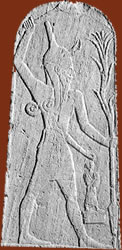Jewish Religious TattoosThere is a passage in the Old Testament that prohibits tattooing and
scarification. In the King James translation, Leviticus 19:28 states: "Ye shall
not make any cuttings in your flesh for the dead, nor print any marks upon you."
Other historical records and biblical passages indicate that ancient Hebrews
practiced religious tattooing.
|
|

Ancient Semitic God Baal |
As evidence of tattooing among Semites, Scutt and Gotch report that the sun god
Baal required his worshipers to mark their hands with "divine tokens in a mystic
attempt to acquire strength." Scutt, R.W.B. and Gotch, C. 1986, Art, Sex and
Symbol. London: Cornwall Books, p.64
According to a biblical scholar William McClure Thomson, Moses "either
instituted such a custom (tattooing) or appropriated one already existing to a
religious purpose. Thomson quotes Exodus 9 & 16: "And thou shalt show thy son in
that day, saying, this is done because of that which the Lord did unto me when I
cam forth out of Egypt; and it shall be for a sign unto thee upon my hand, and
for a memorial between thine eyes." Thomas theorizes that Moses borrowed
tattooing from the Arabs who tattooed magical symbols on their hands and
foreheads.
According to Thomson, the prohibition in Leviticus referred only to heathen
tattooing which related to idols and superstition, and not to "Moses-approved"
tattooing.
During the first quarter of the 20th century, European Jews rarely tattooed
their bodies. Many felt that is was against their religion and beliefs to mark
their skin and this made the holocaust tattooing a even greater atrocity that
would haunt survivors for the rest of their lives.
Tattoo Museum Bibliography, Resources and Links
NEXT >>
Christian Tattoos
